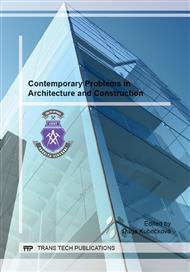[1]
ANSYS Inc. ANSYS User Documentation. ANSYS Inc. (2006).
Google Scholar
[2]
J. Brozovsky, M. Jasek and D. Mikolasek, Numerical Modelling of Reinforced Masonry Arches, in Proceedings of the Eleventh International Conference on Computational Structures Technology, Civil-Comp Press, Stirlingshire, United Kingdom, paper 121, (2012).
DOI: 10.4203/ccp.99.121
Google Scholar
[3]
J. Brožovský, O. Sucharda. Static analysis of masonry structures based on Chen criteria. Civil-Comp Proceedings, 88, (2008).
Google Scholar
[4]
R. Cajka, P. Mateckova, M. Stara, M. Janulikova. Testing of pre-stressed masonry corner for tri-axial stress-strain analysis Life-Cycle and Sustainability of Civil Infrastructure Systems - Proceedings of the 3rd International Symposium on Life-Cycle Civil Engineering, IALCCE 2012, pp.1955-1958 (2012).
DOI: 10.1201/b12995-8
Google Scholar
[5]
M. Jasek, Strengthening of Masonry Pillar with Carbon Cloth (in Czech), Transactions of the VSB - Technical University of Ostrava. Civil Engineering Serie. 12/2 (2012), 167-174.
Google Scholar
[6]
F. Portioli, L. Cascini, M. D'Aniello and R. Landolfo, A Rigid Block Model with Cracking Units for Limit Analysis of Masonry Walls subject to In-Plane Loads, in Proceedings of the Eleventh International Conference on Computational Structures Technology, B.H.V. Topping, (Editor), Civil-Comp Press, Stirlingshire, United Kingdom, paper 117, (2012).
DOI: 10.4203/ccp.99.117
Google Scholar
[7]
M. Stara, R. Čajka, P. Mateckova and M. Janulikova. Laboratory Measurement of Prestressed Masonry. Transactions of the VŠB - Technical University of Ostrava. Construction Series. 2012-01-1, XII, issue 1, pp.1-6 (2012).
DOI: 10.2478/v10160-012-0008-4
Google Scholar
[8]
K. J. Willam, E. P. Warnke Constitutive Models for Triaxial Behaviour of Concrete Subjected to Triaxial Stresses, Int. Assoc. Bridge Struct. Eng. Proc., Vol. 19, (1975), 1–30.
Google Scholar
[9]
J. Witzany, T. Cejka, R. Zigler, Strenghtening of Historical Masonry Vaults and Pillars with Carbon Fabric, First Middle East Conference on Smart Monitoring, Assessment and Rehabilitation of Civil Structures, SMAR20 11, UAE, (2011).
Google Scholar
[10]
A. Zucchini, P. B. Lourenco, A Coupled Homogenisation-Damage Model for Masonry Cracking, Computers and Structures 82, (2004), 917-929.
DOI: 10.1016/j.compstruc.2004.02.020
Google Scholar



